Quick Eval enables you to use a single location to view all student submissions that are awaiting evaluation. Submissions made to Assignments, Quizzes, and Discussions are displayed in a list and can be selected to take you directly to their assessment page.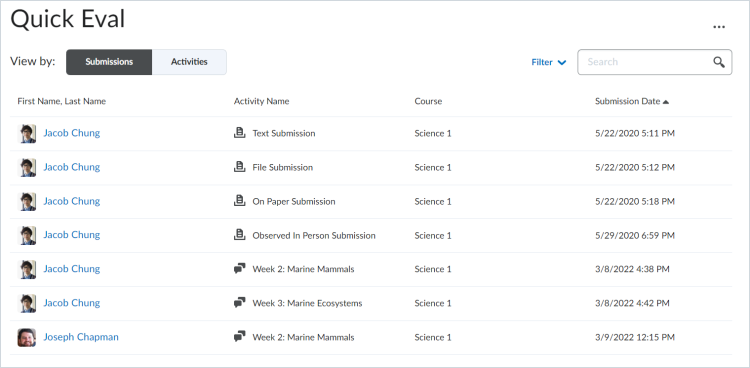
Figure: The Submissions tab of the Quick Eval page.
Click on a student’s name to open an evaluation screen directly from the Quick Eval list where you can complete your assessment.
Turnitin recently introduced an AI tool designed to assist instructors in detecting AI-generated content in student submissions. This tool potentially analyzes writing styles and may detect anomalies that could possibly indicate the use of generative AI. However, while this technology represents a significant step forward, caution is advised in its application. It’s important to recognize that the tool is not infallible and may not catch every instance of AI-generated content. Instructors should not rely on the AI tool to detect AI generated content, but rather, use it as one of several strategies in a comprehensive approach to uphold academic standards and encourage genuine student learning and creativity.
Quick Eval submission type and behavior
The following behavior applies to submitted Assignments:
- A submissions is listed when a student submits a file or text, or marks an assignment as complete.
- Assignments remain visible until you publish feedback for the submission.
- If a resubmission is made by the student, it is added to the Quick Eval list.
- Submissions with their feedback in draft status display a draft icon to indicate their status.
- For assignments with the completion type Automatically on due date, when the due date passes, all submissions display in Quick Eval.
- Assignments with the completion type Automatically on Evaluation are not displayed in Quick Eval.
- Evaluators only see assignment submissions from students in sections they are enrolled in.
The following behavior applies to submitted Quizzes:
- A submission is listed when a student completes a quiz that requires manual grading.
- Once the quiz attempt is graded and saved, it is considered evaluated and no longer displays in Quick Eval.
- If a quiz is setup without the Automatic Export to Grades setting, then a quiz attempt evaluation from Quick Eval does not export to Grades. The evaluator must navigate to the Quizzes tool and select the quiz attempts to publish to the gradebook
- Evaluators only see quiz attempts from students in sections they are enrolled in.
The following behavior applies to submitted Discussions:
- A submission is listed when assessable discussion topics have a post or a reply written by a student.
- When the feedback on a discussion post is saved or published, the student submission is no longer displayed in Quick Eval
- Submissions with feedback in draft status display a draft icon to indicate their status.
- Evaluators only see discussion posts from students in sections they are enrolled in.
Turnitin recently introduced an AI tool designed to assist instructors in detecting AI-generated content in student submissions. This tool potentially analyzes writing styles and may detect anomalies that could possibly indicate the use of generative AI. However, while this technology represents a significant step forward, caution is advised in its application. It’s important to recognize that the tool is not infallible and may not catch every instance of AI-generated content. Instructors should not rely on the AI tool to detect AI generated content, but rather, use it as one of several strategies in a comprehensive approach to uphold academic standards and encourage genuine student learning and creativity.
Sort and filter submissions in Quick Eval
You can sort submissions by first or last name, Activity Name, Course Name, or Submission date. Filter submissions by Activity Name, Course Name, and Submission Date.
When accessing Quick Eval from a specific course, the list of activities to evaluate is prefiltered to only show items from that course. To view submissions from all available courses, click the ellipses icon and select Multi-Course Quick Eval.
Submissions view supports anonymous marking for assignments created with the Hide student names during assessment option selected. Student names and profile images do not display and are replaced by a generic profile image, and the name column shows Anonymous User.
The search function in Quick Eval allows evaluators to locate submissions for evaluation by searching for a specific user, assignment, quiz, discussion topic, or course. Once you complete an evaluation, publish your feedback or save it as a draft and then return to the Quick Eval list to continue evaluating. Any assessment awaiting evaluation, or with its evaluation saved in draft status displays in Quick Eval.
Turnitin recently introduced an AI tool designed to assist instructors in detecting AI-generated content in student submissions. This tool potentially analyzes writing styles and may detect anomalies that could possibly indicate the use of generative AI. However, while this technology represents a significant step forward, caution is advised in its application. It’s important to recognize that the tool is not infallible and may not catch every instance of AI-generated content. Instructors should not rely on the AI tool to detect AI generated content, but rather, use it as one of several strategies in a comprehensive approach to uphold academic standards and encourage genuine student learning and creativity.
View activities in Quick Eval
In Quick Eval, select the Activitiestab to display a list of any assessable activities that have one or more submissions, regardless of the submission status. This view makes it easy to complete all assessments for one assignment, discussion, or quiz before moving on to the next task.

Figure: The Activities tab of the the Quick Eval page.
Activities view displays indicators to show the students progress on submissions, teachers progress on evaluations, and on publishing feedback to students. It also includes links to the evaluation page, submission page, and a publish all action.
A new count is displayed for Assignments, Quizzes, and Discussions. It corresponds to the sum of student submissions that have never been evaluated or resubmitted since the last evaluation (either draft or published).
An activity shows up in Quick Eval’s Activities view when there is an assessable activity that has one or more submissions, regardless of the submission status (i.e. either awaiting evaluation status or evaluated).
Turnitin recently introduced an AI tool designed to assist instructors in detecting AI-generated content in student submissions. This tool potentially analyzes writing styles and may detect anomalies that could possibly indicate the use of generative AI. However, while this technology represents a significant step forward, caution is advised in its application. It’s important to recognize that the tool is not infallible and may not catch every instance of AI-generated content. Instructors should not rely on the AI tool to detect AI generated content, but rather, use it as one of several strategies in a comprehensive approach to uphold academic standards and encourage genuine student learning and creativity.
Use the Submissions view
Submissions provides a list of all learner submissions that are awaiting evaluation across all the instructor’s courses. The assessments remain visible until the evaluator publishes a grade and feedback.
To use the submissions view
- Click Submissions on the View By toggle.
- To filter the Submissions view, click to expand the Filters drop-down menu.
Note: If you are looking for a specific submission, use the search bar. - Select one of the filter options:
- Activity Name
- Course
Note: This is not visible if you are viewing Quick Eval at the course level. - Date
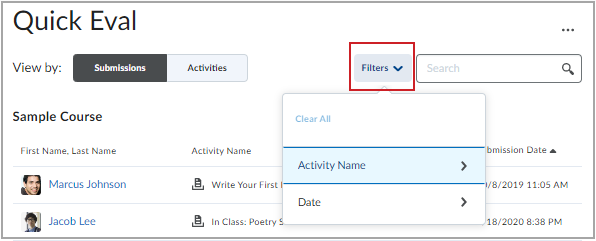
Figure: The Submissions Filter view displaying the filter options for a course-level view
- Browse to the learner you want to evaluate and click the learner’s name to open their submission.
Turnitin recently introduced an AI tool designed to assist instructors in detecting AI-generated content in student submissions. This tool potentially analyzes writing styles and may detect anomalies that could possibly indicate the use of generative AI. However, while this technology represents a significant step forward, caution is advised in its application. It’s important to recognize that the tool is not infallible and may not catch every instance of AI-generated content. Instructors should not rely on the AI tool to detect AI generated content, but rather, use it as one of several strategies in a comprehensive approach to uphold academic standards and encourage genuine student learning and creativity.
Evaluate submissions in Quick Eval
You can evaluate assignments, quizzes, and discussions from the Quick Eval list.
To evaluate an assignment
- From your course navbar, click Quick Eval.
- Click an assignment submission from the Quick Eval list to be taken to an evaluation page for that assignment.
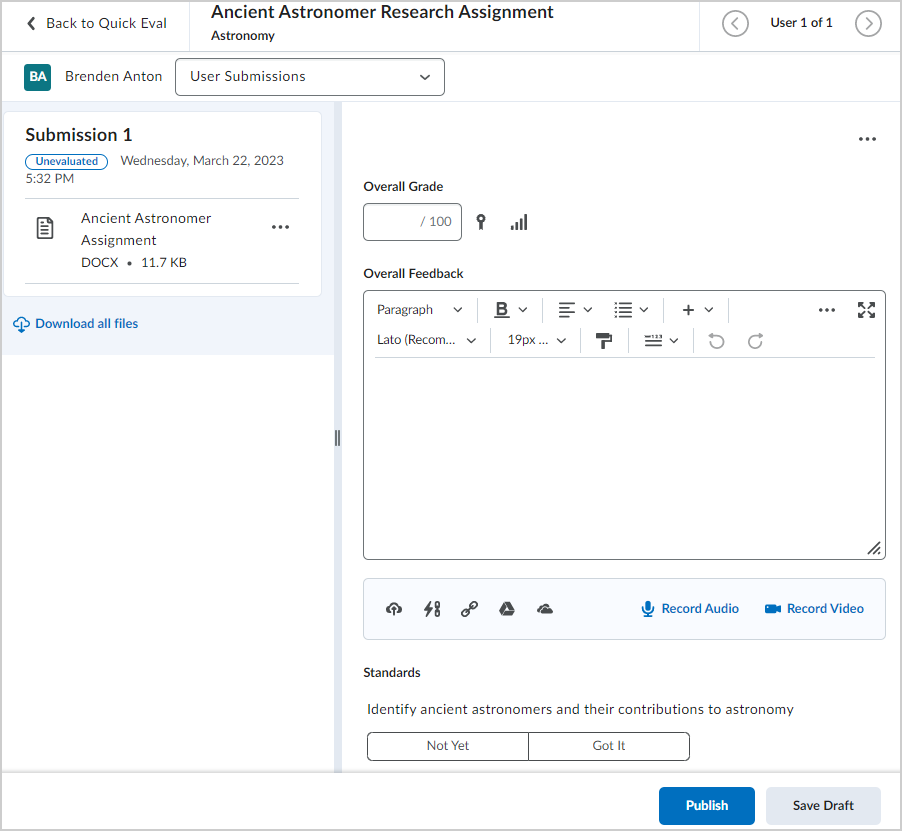
Figure: The evaluation page for an assignment. - Enter an Overall Grade and Overall Feedback for the assignment.
- If you have linked the assignment to Standards, select a standard.
- Click Publish.
To evaluate a quiz with Quick Eval
- From Quick Eval, access the quiz you want to grade.
- On the quiz evaluation page, select the attempt and scroll through learner responses.
- On the written response submission, review the learner submission and enter a score.
- Include feedback using Brightspace Editor (optional).
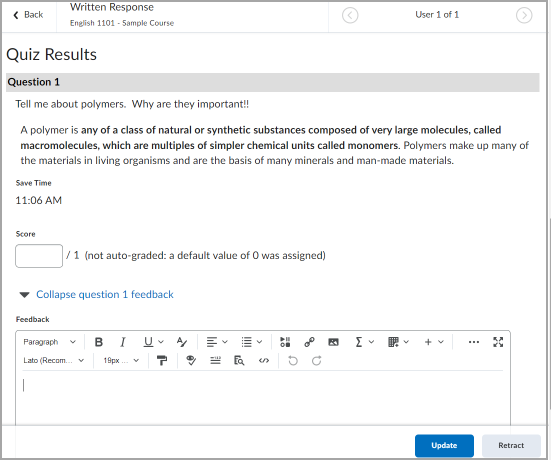
Figure: The Score and Feedback fields to evaluate written response quiz questions. - Click Update.
- Do one of the following:
- To move to the next learner submissions, click the right-facing Advance Arrow in the top right of the window.
- To return to Quick Eval, click Back to Quick Eval in the top left of the window.
To evaluate a discussion with Quick Eval
- From Quick Eval, select the discussion topic you want to grade.
- Review the learner discussion topic and any replies, if applicable.
- If you are evaluating a graded discussion, add a discussion score using the following fields:
- Enter a value in the Overall Grade field.
- If you have a rubric attached to the assignment activity, select the rubric and complete the rubric scoring criteria.
- If you want to include text, audio, or video feedback, include it using the Brightspace Editor in the Overall Feedback field.
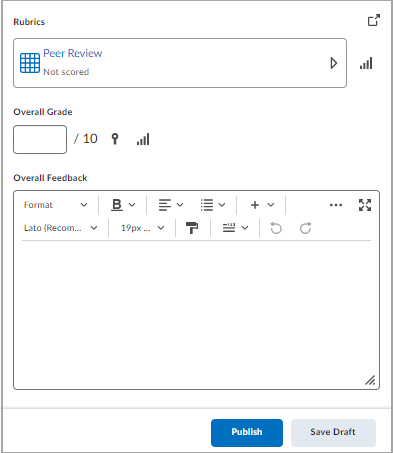
Figure: The Rubrics, Overall Grade, and Overall Feedback fields to evaluate a Discussion topic.
- After you have completed the feedback, do one of the following:
- Click Publish to make the feedback available to the learner.
- Click Save Draft to save completed feedback, but do not release it to the learner. For more information about saving drafts, see Optional Steps if you Save feedback drafts.
- Do one of the following:
- To move to the next learner submissions, click the right-facing Advance Arrow in the top right of the window.
- To return to Quick Eval, click Back to Quick Eval in the top left of the window.
Once evaluation of an individual submission is complete, click Back to Quick Eval to return to the Quick Eval tool at the course level or org level, depending on where you launched it from, and continue evaluating.
Turnitin recently introduced an AI tool designed to assist instructors in detecting AI-generated content in student submissions. This tool potentially analyzes writing styles and may detect anomalies that could possibly indicate the use of generative AI. However, while this technology represents a significant step forward, caution is advised in its application. It’s important to recognize that the tool is not infallible and may not catch every instance of AI-generated content. Instructors should not rely on the AI tool to detect AI generated content, but rather, use it as one of several strategies in a comprehensive approach to uphold academic standards and encourage genuine student learning and creativity.
Use the Activities View
Activities provides a pre-sorted list of all required assessments for an assignment, discussion, or quiz, making it easy to complete one task before moving on to the next. Activities displays indicators to show learner progress on submissions, and instructor progress on evaluations and publishing feedback to learners. It also links to the Evaluation page, Submission page, and provides a Publish All action to enable you to release all evaluations simultaneously.
To use the activities view
- Click Activities on the View By toggle.
- To filter the Activities view, click to expand the Filters drop-down menu.
- Do one of the following:
- Filter by Activity Name or Course, and click the number indicating the new discussion topic, submission, or quiz attempt.
- Begin evaluating by clicking the activity and the number indicating the new discussion topic, submission, or quiz attempt.
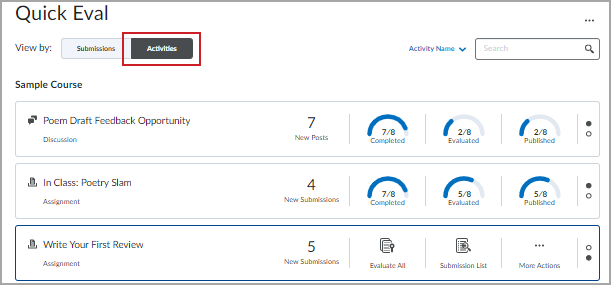
Turnitin recently introduced an AI tool designed to assist instructors in detecting AI-generated content in student submissions. This tool potentially analyzes writing styles and may detect anomalies that could possibly indicate the use of generative AI. However, while this technology represents a significant step forward, caution is advised in its application. It’s important to recognize that the tool is not infallible and may not catch every instance of AI-generated content. Instructors should not rely on the AI tool to detect AI generated content, but rather, use it as one of several strategies in a comprehensive approach to uphold academic standards and encourage genuine student learning and creativity.
Dismiss Activities
When you dismiss an activity, it is hidden from the Quick Eval list, but won’t affect the activity. A dismissed activity is still available for evaluation from its own tool (Assignments, Quizzes, Discussions).
To dismiss activities
- From your course navbar, click Quick Eval.
- From the View by options, click the Activities tab.
- Hover over the activity you want to dismiss and click More Actions > Dismiss until.
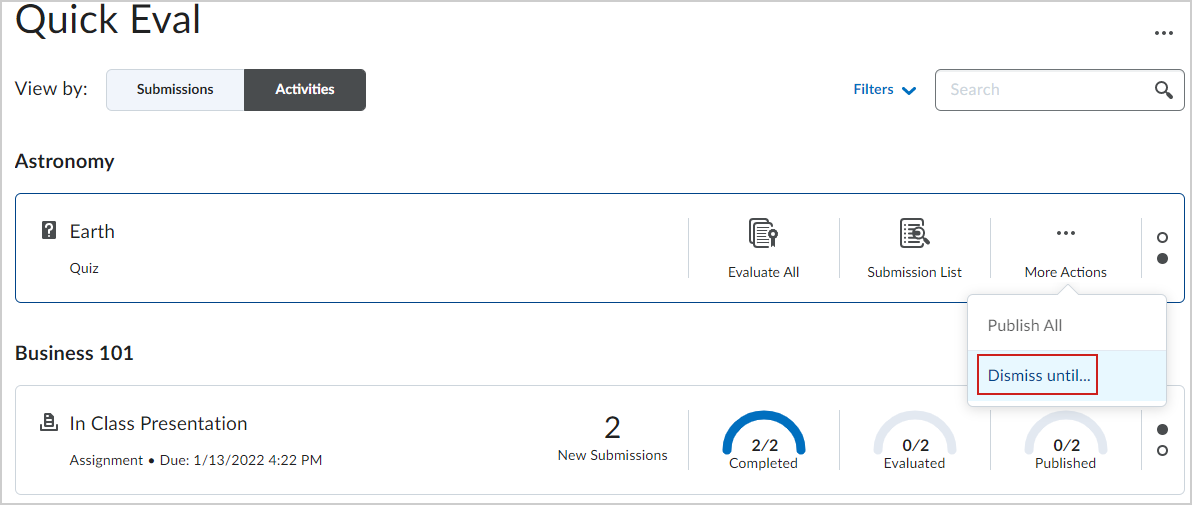
Figure: The Dismiss until option for an activity. - Select one of the following:
- A specific date and set how long you want to dismiss the activity for
- Forever
- Dismiss Until Next Submission
- Select Dismiss Activity.
The activity remains dismissed until the selected condition is met, or you manually restore it using the ellipsis icon in Quick Eval.
Turnitin recently introduced an AI tool designed to assist instructors in detecting AI-generated content in student submissions. This tool potentially analyzes writing styles and may detect anomalies that could possibly indicate the use of generative AI. However, while this technology represents a significant step forward, caution is advised in its application. It’s important to recognize that the tool is not infallible and may not catch every instance of AI-generated content. Instructors should not rely on the AI tool to detect AI generated content, but rather, use it as one of several strategies in a comprehensive approach to uphold academic standards and encourage genuine student learning and creativity.
Restore Activities
You can also restore activities that have been hidden.
To restore activities
- From your course navbar, click Quick Eval.
- Click Quick Eval More Actions and select Dismissed activities.
- Select the check box of the item you want to restore and click Restore.
Turnitin recently introduced an AI tool designed to assist instructors in detecting AI-generated content in student submissions. This tool potentially analyzes writing styles and may detect anomalies that could possibly indicate the use of generative AI. However, while this technology represents a significant step forward, caution is advised in its application. It’s important to recognize that the tool is not infallible and may not catch every instance of AI-generated content. Instructors should not rely on the AI tool to detect AI generated content, but rather, use it as one of several strategies in a comprehensive approach to uphold academic standards and encourage genuine student learning and creativity.
Quick Eval widget
The Quick Eval widget can be added to a course homepage and allows teachers to view and access any submissions awaiting evaluation. The Quick Eval widget displays a list of up to six activities with submissions to evaluate. The activities are sorted by due date, with the earliest date first. The icon indicator in the widget shows the type of activity (assignment, discussion, or quiz), and the number of unevaluated submissions for each activity.
If the Quick Eval widget is placed on the organization level homepage it displays information from all active courses.
Turnitin recently introduced an AI tool designed to assist instructors in detecting AI-generated content in student submissions. This tool potentially analyzes writing styles and may detect anomalies that could possibly indicate the use of generative AI. However, while this technology represents a significant step forward, caution is advised in its application. It’s important to recognize that the tool is not infallible and may not catch every instance of AI-generated content. Instructors should not rely on the AI tool to detect AI generated content, but rather, use it as one of several strategies in a comprehensive approach to uphold academic standards and encourage genuine student learning and creativity.

